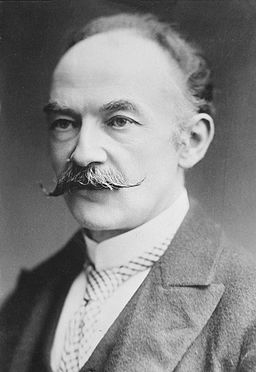Claire Tomalin declares Thomas Hardy ‘the time-torn man’ in her biography of him, a phrase borrowed from his poem ‘A Broken Appointment.’ This is a fitting description considering that Hardy was born in 1840 during the mid-Victorian period, yet died in 1928 at the peak of the modernist era. He could therefore be seen as belonging to both periods, and this is reflected in his literary works.
Hardy was born in Stinsford, a small village in Dorset. He was educated at an academy in Dorchester and then became an architect’s apprentice. Although he moved to London in 1862 to study at King’s College London and continue his career as an architect, he moved back to Dorset five years later and began writing his novels.
Hardy’s home county had a profound influence on his writing, as many of his novels are set in his invented county of ‘Wessex,’ which was based on Dorset and other neighbouring counties. In contrast to large industrial cities like London where many popular Victorian novels were set, Hardy’s novels take place in small villages and towns, so it is unsurprising that nature is a crucial theme in all of his works. He pays particular attention to the rural landscape of Dorset, describing in detail how it changes when a character travels from one area to another, and using it to enhance romantic scenes between characters. This is particularly prominent in Tess of the d’Urbervilles (1891):
Thus during this October month of wonderful afternoons they roved along the meads by creeping paths which followed the brinks of trickling tributary brooks, hopping across by little wooden bridges to the other side and back again. They were never out of the sound of some purling weir, whose buzz accompanied their own murmuring, while the beams of the sun, almost as horizontal as the mead itself, formed a pollen of radiance over the landscape. They saw tiny blue fogs in the shadows of trees and hedges, all the time that there was bright sunshine elsewhere. The sun was so near the ground, and the sward so flat, that the shadows of Clare and Tess would stretch a quarter of a mile ahead of them, like two long fingers pointing afar to where the green alluvial reaches abutted against the sloping sides of the vale.
Class is another major theme in Hardy’s novels. He has written about cross-class relationships, and some of his main characters including Giles Winterborne in The Woodlanders (1887) and Tess Durbeyfield in Tess of the d’Urbervilles (1891) are agricultural labourers. Both novels emphasise how gruelling this labour was, with Hardy criticising the harsh working conditions and the exploitation of the labourers. Hardy has also written extensively on the treatment of women, and his novels have caused controversy by depicting female characters who are sexually assaulted, and in the case of The Mayor of Casterbridge (1886), literally sold off. Although he has been criticised for eroticising some of his female characters, Hardy has done important work in using his novels to show how women in Victorian society were often unfairly blamed for the mistreatment they experienced.

St Oswald’s Bay near Lulworth Cove, Dorset. Photograph taken by Adrian Pingstone via Wikimedia commons.
Hardy did not publish any novels in the twentieth century, instead turning his focus to poetry. Many of his poems were about time, perhaps due to the turn of the century and Hardy’s aging. One of his most famous poems, ‘The Darkling Thrush,’ was published in 1900. In the setting of a bleak winter landscape which is compared to ‘The Century’s corpse,’ the poem’s speaker appears to be undergoing a crisis of faith. However, they spot ‘An aged thrush, frail, gaunt, and small,’ that sings ‘In a full-hearted evensong / Of joy illimited.’ This makes the speaker think that ‘there trembled through / His happy good-night air / Some blessed Hope, whereof he knew / And I was unaware.’ The optimistic ending of the poem shows the importance of turning to nature in order to find hope. Hardy also wrote several poems about World War I, such as ‘And There Was a Great Calm’ and ‘A New Year’s Eve in War Time.’ These poems criticised the brutality of war and shed a light on the agonising experience of the soldiers. They were also thought to have inspired other war poets such as Rupert Brooke and Siegfried Sassoon.
Thomas Hardy could be seen as bridging the gap between literature of the nineteenth and twentieth centuries. His novels clearly fit into the category of Victorian realism, while his poetry reflects the modern concerns of the twentieth century. However, the unifying strength of all his literature is its ability to show the richness of human experience.


